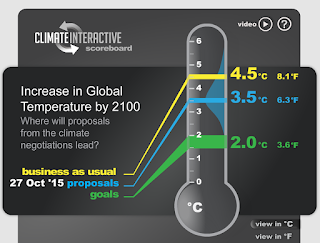Distinct chapters can be seen throughout the evolution of my blog. First, I started by outlining the evidence behind why we really need a new international agreement, and science (or lack of) behind the 2C target. From here, the blogs assessed and analysed past climate negotiations within the framework of debates on 'top down' or 'bottom up' approaches. This included specific analysis of the INDC's and what, in their beta form, they really mean for climate progress. My blog also aimed to capture slightly less scientific elements of COP21, including the wider publics response specifically though my own personal experience of the climate marches preceding the conference. Finally, the blog aimed to analyse the key terms of the Paris agreement, highlighting areas of change, improvement and concern in the context of my previous blogs.
I personally think, all things considered, that the Paris agreement is a true landmark climate deal, exceeding many of my expectations going into the conference. Although it has been suggested the agreement does not go far enough, and in may ways it does not, I do not believe that COP21 is a "cop-out". The recognition of a 1.5 degree target, the long term goal of zero net emissions and the break down in differentiation alone make COP21 more successful than all the previous deals. Furthermore, despite its shortcomings in ensuring necessary emission reductions (yet), I do strongly believe that the agreement presents a significant signal to the business and financial communities, marking the beginning of the end for fossil fuels and promoting real change in the economy. Yes these are only signals, but responses to climate change are not just top down, they are also bottom up.
This is where the Paris Agreement marks its most significant departure from previous diplomacy. The introduction of the INDC's and future progressive review mechanisms, asks nations what they are willing to do rather than telling them what they should do. For the sake of not killing their own population, peer pressure might just be enough to make countries really act on their laurels. The failure of previous top-down approaches led to strong arguments calling for a change in approach to climate governance. In my opinion the Paris agreements marks the best of both worlds, including overall governance and review by the UNFCCC, yet action from the bottom up where change is really going to originate from. As the Guardian review editorial on COP21 argues, the outcome of the Paris Agreement re-establishes a new form of progressive 'determined diplomacy' in increasingly narrow and nationalistic times.
However, although the adoption of the Paris agreement marks a significant new chapter in climate governance, the objectives are far from being achieved. One of my greatest disappointments with the deal is the fact that although the review mechanism and obligation to set nationally determined contributions are legally binding, their actual enforcement is not. This must be amended. Although country peer pressure has led to this agreement, and may in fact be enough, the health of the planet cannot be risked.
Furthermore, now an agreement has been made, I strongly believe the scientific targets and methods of reviewing progress should be refined and updated. Although a "well below" 2C target is a great starting point and effective way of communicating the importance of rising temperature, an improved method for assessing and defining the safe operating space for humanity is required. Although by no means perfect, approaches such as the Planetary Boundary Framework (Stefan et al. 2015), assessing the limits of the earth system appear to present one such solution.
Thank you for reading!
Thank you for reading!













